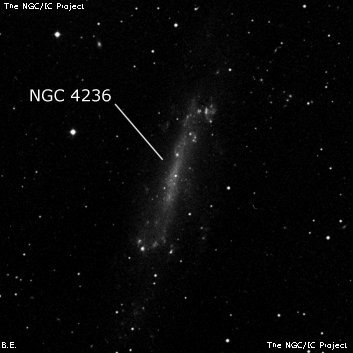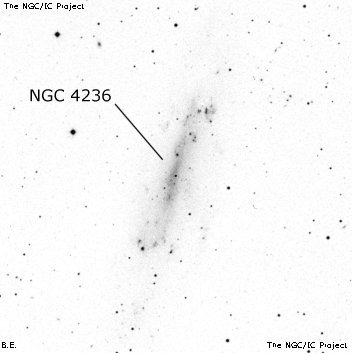NGC/IC Project Restoration Effort
(This is a very very beta version)
NGC4236


Basic Information
Location and Magnitude
Right Ascension: 12:16:43.3
Declination: +69:27:49
Constellation: DRA
Visual Magnitude: 9.6
Historic Information
Discoverer: Herschel W.
Year of discovery: 1793
Discovery aperture: 18.7
Observational
Summary description: vF, eL, mE 160° ±, vgbM
Sub-type: SBdm
Corwin's Notes
=====
NGC 4236. While there is no question about the identification of this large,
low surface brightness galaxy, its accurate position is not easily determined.
There is no nucleus visible at any wavelength in which the galaxy has yet been
examined, so the published positions are all either estimates, or refer to
various other features within the galaxy. The position that I've adopted is
an estimated center of the bar as seen on the red DSS2 image. This position
is within about 20 arcseconds of a superposed "late G-type star" (according to
Lira et al, MNRAS 382, 1552, 2007, who have a spectrum).
Steve's Notes
=====
NGC 4236
18" (4/26/08): this huge, low surface brightness galaxy extends roughly 12'x3', oriented NNW-SSE. There is only a very weak central brightening with no obvious core. A very faint star appears to be superimposed near the geometric center and just to the south is a slightly elongated brightening (possibly the core).
Another brighter region is near the north end of the galaxy. This patch seems elongated at 45ˇ to the major axis, appearing to extend out to the west of the main glow on the north end. Images reveal this is a gigantic HII complex and is catalogued in the Hodge-Kennicutt Atlas of HII regions (1983AJ, 88, 296) as NGC 4236:[HK83] 15, 16 and 17.
The south end is also splotchy and at the very south tip are two very faint "stars" that seemed slightly fuzzy. These are also two small HII knots, listed as NGC 4236:[HK83] 02 and 03. One or both of the knots also carry the designation VII Zw 446, described by Zwicky as a "blue patchy compact [galaxy]".
17.5" (3/29/89): faint, extremely large, edge-on 5:1 NNW-SSE. Appears as a ghostly streak about 20' length with only a broad, weak concentration! Best at low power due to size and low surface brightness.
13.1" (5/27/84): faint, very large, very elongated NNW-SSE, weak concentration. In a field with five mag 8-9 stars.



